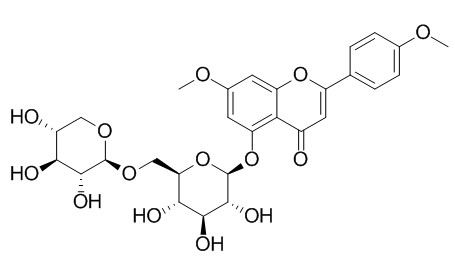7,4'-Di-O-methylapigenin 5-O-xylosylglucoside
7,4'-Di-methylapigenin-5-O-xylosylglucoside shows inhibitory activity for nitric oxide(NO) production by activated RAW 264.7 cells.
Inquire / Order:
manager@chemfaces.com
Technical Inquiries:
service@chemfaces.com
Tel:
+86-27-84237783
Fax:
+86-27-84254680
Address:
1 Building, No. 83, CheCheng Rd., Wuhan Economic and Technological Development Zone, Wuhan, Hubei 430056, PRC
Providing storage is as stated on the product vial and the vial is kept tightly sealed, the product can be stored for up to
24 months(2-8C).
Wherever possible, you should prepare and use solutions on the same day. However, if you need to make up stock solutions in advance, we recommend that you store the solution as aliquots in tightly sealed vials at -20C. Generally, these will be useable for up to two weeks. Before use, and prior to opening the vial we recommend that you allow your product to equilibrate to room temperature for at least 1 hour.
Need more advice on solubility, usage and handling? Please email to: service@chemfaces.com
The packaging of the product may have turned upside down during transportation, resulting in the natural compounds adhering to the neck or cap of the vial. take the vial out of its packaging and gently shake to let the compounds fall to the bottom of the vial. for liquid products, centrifuge at 200-500 RPM to gather the liquid at the bottom of the vial. try to avoid loss or contamination during handling.
Int J Mol Sci.2015, 16(1):1232-51
Phytomedicine.2018, 40:37-47
Mol Biol Rep.2023, 50(5):4029-4038.
Arch Biochem Biophys.2024, 759:110111.
FEBS Lett.2021, 595(20):2608-2615.
Pharmaceuticals (Basel).2021, 14(10):1046.
Chem Res Toxicol. 2022, acs.chemrestox.2c00049.
Antibiotics.2022, 11(4), 510.
Front Immunol. 2020, 11:62.
Eur J Pharmacol.2023, 950:175772.
Related and Featured Products
Chinese Journal of Natural Medicines, 2012,10(4): 287-91.
Flavanoids from the stems of Aquilaria sinensis[Reference:
WebLink]
To study the chemical constituents from the stems of Aquilaria sinensis (Lour.) Gilg. Chromatographic separations of silica gel, Sephadex LH-20 and prep-HPLC were used.
METHODS AND RESULTS:
All the structures were elucidated on the basis of chemical and spectroscopic analysis.Twelve flavonoids were isolated and their structures were identified as aquilarinoside A1 (1), lethedioside A (2), 7, 4′-dimethylapigenin-5-O-xylosylglucoside (7,4'-Di-O-methylapigenin 5-O-xylosylglucoside,3), lethedoside A (4), 7-hydroxyl-4′-methyl-5-O- glucosideflavonoid (5), 7, 3′-dimethyl-4′-hydroxyl-5-O-glucosideflavonoide (6), 7, 4′-dimethyl-5-O-glucosideflavonoide (7), 5-hydroxyl-7, 4′-dimethoxyflavone (8), luteolin-7, 3′, 4′-trimethyl (9), hydroxylgenkwanin (10), 5, 7-dihydroxyl-4′-methoxyflavone (11), and formononetin (12).Compound 1 is a new flavone glycoside, and compounds 2, 4-7 were isolated from genus Aquilaria sinensis for the first time.
CONCLUSIONS:
5-O-glycosylflavones 1-7 showed inhibitory activity for nitric oxide (NO) production by activated RAW 264.7 cells.



